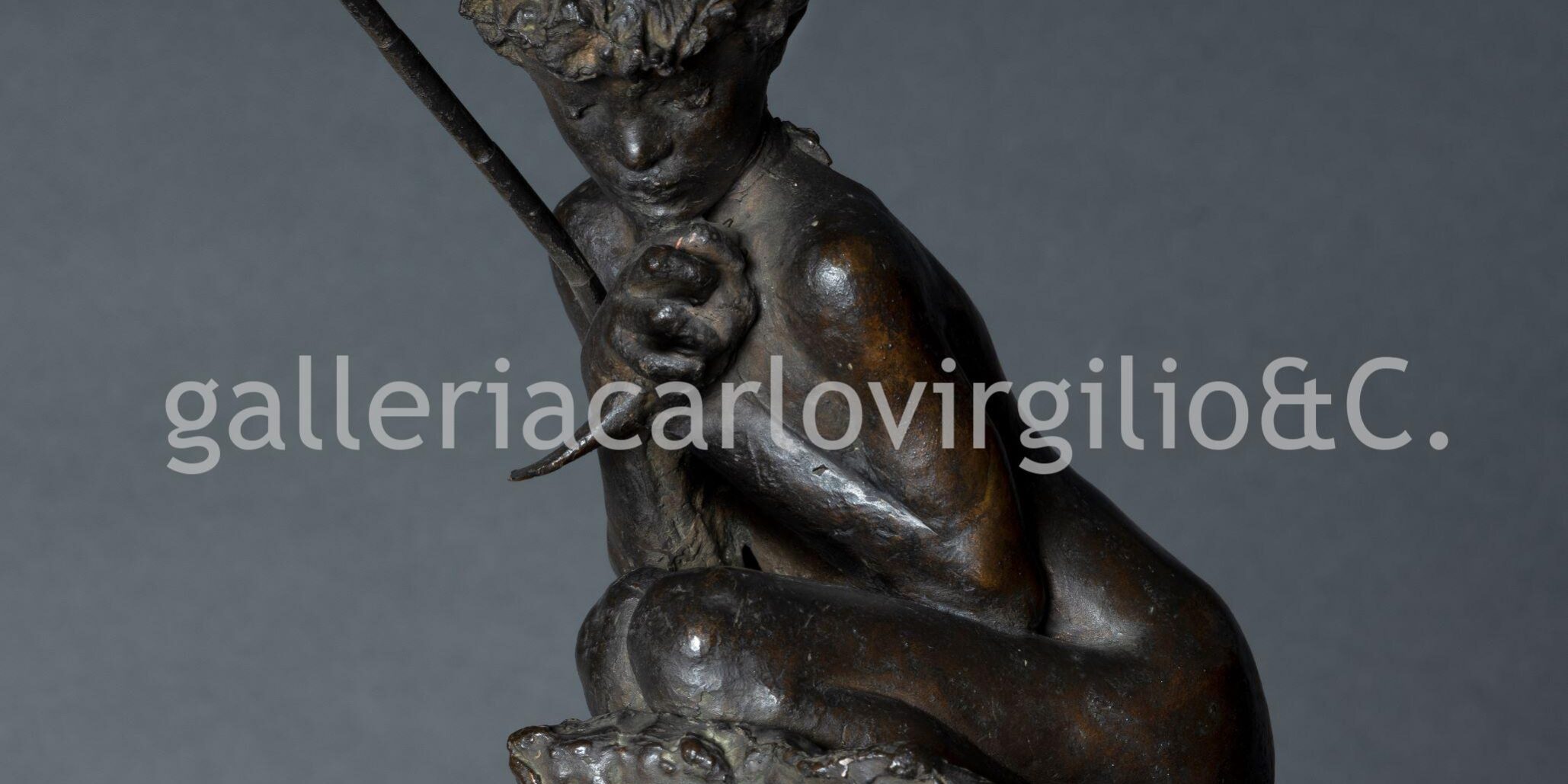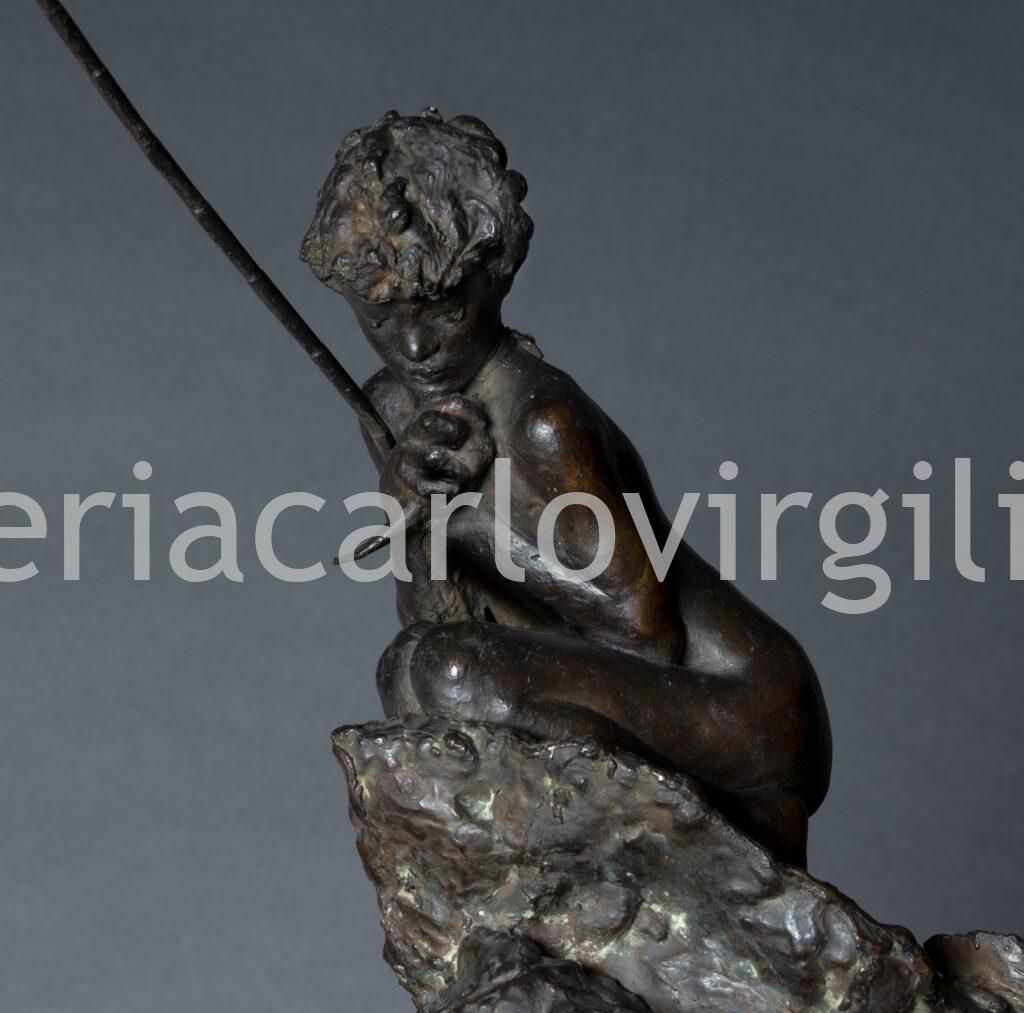| NOT AVAILABLE

Gemito Vincenzo
Naples 1852-1929
Il Pescatoriello Marvasi (The Marvasi Fisherboy) • 1876
Bronze, h 27 × 25 cm
Bibliography: Salvatore Di Giacomo, Vincenzo Gemito. La vita – L’opera, Naples 1905, pp. 26 (ill.), 39-43; Esposizione e vendita a trattative private della collezione di opere d’arte antica e moderna raccolta dal comitato esecutivo a beneficio della erigenda opera ospedaliera pro orfani dei contadini meridionali morti in guerra – Presidente dell’opera S. Ecc. l’Onorevole Prof. Raffaele Caporali, catalogo della Vendita, Napoli, Sala Tarsia, Naples, Stabilimento P. Roseo, 1920, reparto M, cat. 310, p. 27; Alfredo Schettini, Gemito, Milan 1944, cit. p. 200, tav. 24 (illustrated the specimen of the Minozzi collection); Carlo Siviero, Gemito, Naples 1953, p. 194, tav. 43, p. 210; Salvatore Di Giacomo, Gemito, Naples 1988, p. 32, illustrated.
This work is the first exemplar in bronze of the Fisherboy by Vincenzo Gemito, commissioned in 1876 by the mayor of Naples, Diomede Marvasi. The bronze shows the high surface quality of an original sculpture – perhaps designed as a one off – from which the fragrance of wax used in its making clearly emerges. The artist has avoided as much as possible intervening with a chisel finish, and has deliberately not filed off a part of the casting core to keep the metal alloy’s primitive aspect, found in the highest bronze production of antiquity.
In the mid seventies the sculptor made several works for his illustrious patron, Marvasi, such as portraits of his three children, among which the terracotta of little Guido from 1874 stands out; as does a pen drawing of Silvio’s face from 1878. The relationship between patron and artist is related by Salvatore Di Giacomo, according to whom Marvasi “welcomed Gemito to his hospitable home almost every evening […] the company and vivid conversation of such a new and interesting artist seeming to the austere magistrate, after the daily tension of mind and soul, true recreation and a merciful rest for the spirit.”[1] In the same years in which Gemito frequents the mayor’s house, his interest in ancient sculpture matures, bringing to his own original realism increasingly solid and solemn traits, and marking the passage to a first artistic maturity.
The subject of the Neapolitan Fisherman was not entirely new in the sculptural panorama of the time and already in the first half of the nineteenth century it had been proposed by French sculptors such F. Duret and J.B. Carpeaux,[2] although in a romantic key with folkloristic traits. Not only does Gemito re-interpret the theme with realism, he goes beyond, giving the small figure the collected and composed shapes of classical lineage. Before producing his Fisherboy the sculptor spent a good deal of time on preparatory studies and sketches,[3] sketching from life the lads that populated the coastal rocks of Naples to grasp the most efficacious movement and expression to incarnate his idea. According to Morisani, in elaborating Fisherboy Gemito focussed “with incredible subtlety,”[4] reaching the final version of the work where the protagonist is “a young child, at the age when everything is still soft and radiant. Kneeling somewhat unsteadily on a rock, on the damp, slippery moss, at the culminating moment of his fishing, the catch: now he is holding the little fish, but gently, as if he feared hurting it more than losing it, and afterwards he would cry if he tore the fish’s mouth while removing the hook.”[5]
The work was immediate highly popular, to the point of prompting the artist to make several copies in bronze, not all entirely finished by him and with more polished surfaces. Today some of the most valuable are conserved at the Gallerie d’Arte Moderna of Milan and Turin and in the Intesa Sanpaolo collection in Naples. The Milanese gallery holds the original red coloured wax,[6] given to the artist’s daughter in 1939,[7] from which the first exemplar for the Marvasi collection and those immediately after were most likely taken. A further two-tone wax is conserved at the Galleria d’Arte Moderna in Rome, also a gift from Giuseppina Gemito.[8] 1876, the year our work was made, was significant in the sculptor’s life, as he moved studio to near the Museo Archeologico, an area noted for classical ruins. The critics give different reasons for the move, from his companion Mathilde’s precarious health, to the artist’s desire to immerse himself in the study of ancient sculpture by assiduously frequenting the museum.[9] The latter should be kept in mind when analysing the stylistic choices found in the Fisherboy, since the work – even more than the others produced over same years – presents a solid and synthetic shape that moves away from Gemito’s early pieces, mainly in the infinite material vibrations and its absolute freshness of shape. It is clear that Gemito took ancient sculpture as a point of reference, with a particular leaning to that of the IV and III centuries B.C.E. His interest for antiquity demanded extensive research, given that there was often considered to be a generic kinship between Neapolitan and classical sculpture tout court. From the 1876 Fisherboy it seems Gemito was particularly inspired by Lysippos; indeed, while references to Lysippos appear more evident in his mature works with the series of portraits of Alexander the Great, in his earlier works they are less blatant but equally significant. Gemito shared commonalities with the sculptor from Sicyon not only from a stylistic point of view, but also from a biographical one, given that ancient tradition, still held in nineteenth century studies, considered Lysippos an autodidact of humble origins who at the start of his career chose to work directly from nature rather than to imitate the examples of other masters.[10] In the latter half of the nineteenth century it was believed that the bronze of Seated Hermes, conserved at the Museo Archeologico of Naples, was the work of Lysippos or his school[11] and for some time had been the object of study on the part of the artists gravitating around the academy, as demonstrated by a precocious drawing by Raffaele Postiglione.[12] There are also drawings by Gemito, post-dating the Fisherboy of 1876, such as Luciano[13] of 1911 and Study for the Queen’s Fisherman[14] of 1909, taking up Hermes’ pose, and humanizing the god as a lad of the people. Although the posture in Marvasi Fisherboy appears different from that of Hermes, the later versions of the same subject increasingly tend to resemble it. In any case, the closeness of the two works seems compelling in the rendering of the bronze surfaces and the relationship between the young body and the rock beneath. In Gemito’s sculpture the boy and rock are one and share the same strongly inclined planes. The light seems to fall on the work as if by the force of gravity, and as it runs gently over the small body in an uninterrupted line, when not swallowed by the deep shadows of the face and inclined bust, it re-emerges to catch on the rough surfaces of the rock, which rather than appearing jagged have the aspect of rocks worn down by the sea. As a counterpoint to the innumerable vibrations of light generated by the rocky matter is the boy’s ruffled hair above, which also recalls that of Hermes, as well as the Corridor Statuettes from Herculaneum at the Museo Archeologico in Naples.
Giancarlo Brocca
[1] Di Giacomo 1905, ed. cons. Bonuomo 1988, pp. 44-45
[2] D. M. Pagano 2009, p. 98
[3] Merged into the Minozzi Collection
[4] O. Morisani, p. 60
[5] ibidem
[6] M. S. De Marinis 1993, tav. 19
[7] D. M. Pagano 2009, p. 99
[8] C. Virno 2014, tav. 3, p.87
[9] A. Schiettini 1944, p. 200, tav. 24
[10] Plin. XXXIV, 61 “Lysippum Sicyonium Duris negat ullius fuisse discipulum, sed primo aerarium fabrum audiendi rationem cepisse pictoris Eupompi responso eum enim interrogatum, quem sequeretur antecedentium, dixisse monstrata hominum multitudine, naturam ipsam imitandam esse, non artificem”
[11]Della Seta, I monumenti dell’Antichità classica”, S.A.E. D. Alighieri, Milano 1933
[12] Raffaele Postiglione, Copy of the bronze statue of Seated Hermes, black pastel on paper, 415 x 253mm, Naples, Accademia di Belle Arti
[13] Vincenzo Gemito, Luciano, black pastel on paper, 1911, Naples, private collection
[14] Vincenzo Gemito, Study for the Queen’s Fisherman, pen on paper, private collection
The Carlo Virgilio & C. Gallery searches for works by Gemito Vincenzo (1852-1929)
To buy or sell works by Gemito Vincenzo (1852-1929) or to request free estimates and evaluations
mail info@carlovirgilio.co.uk
whatsapp +39 3382427650
